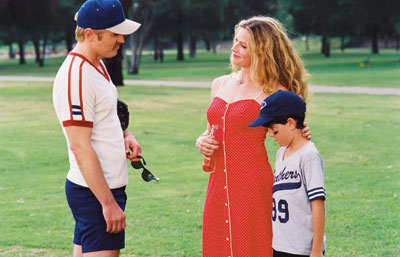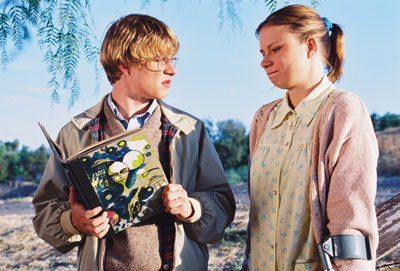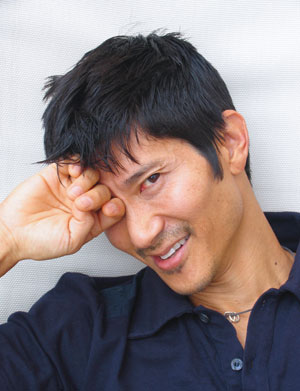THE WONDER YEARS
After a six-year hiatus, Gregg Araki returns to feature filmmaking with Mysterious Skin, a haunting story about childhood sexual abuse.
BY PETER BOWEN
Writer-director Gregg Araki. PHOTO: HENNY GARFUNKEL.
In 1992, Gregg Araki’s The Living End, a story about two HIV-positive lovers on the run, was heralded as a defining film for the New Queer Cinema. What made the film radical wasn’t simply Araki’s gun-toting gay men — a detail that pushed a queer version of Godard’s adage that all you need for a film is “a girl and a gun.” What made The Living End so radical was Araki’s ability to marry so many disparate elements — to unite an experimental aesthetic with radical politics, to transform a Hollywood genre into a cutting-edge adventure. In all of Araki’s films, form and content have a significant relation, whether it be the use of Godardian fragments to express the fractured existence of a group of AIDS-generation gay teens in Totally F***ed Up, or his darkly surreal palette to highlight the sexual apathy of his neo-punk heroes in The Doom Generation, or his use of a bright, screwball-comedy style to capture the political optimism of a ménage-à-trois in Splendor.
Araki’s new film, Mysterious Skin (due out in May from Tartan Films), again uses cinematic form to explore sexuality, but with crucial differences. For one, Mysterious Skin (based on the novel by Scott Heim) is the first work that Araki has adapted rather than created himself. Second, the story depicts a sexuality of trauma rather than liberation. In the film two boys from Kansas — Brian Lackey (Brady Corbet) and Neil McCormick (Joseph Gordon-Levitt of TV’s 3rd Rock from the Sun fame) — who were both sexually abused by their Little League coach (Bill Sage) when they were eight, have devised very different coping mechanisms. Brian has developed a complex, paranoid theory of alien abduction to explain his neurotic repression. Neil, not unlike the characters of Araki’s earlier films, has attempted to embrace his abuse, holding up the coach as his great true love and taking off on an outlaw trail of teen hustling and petty crime.
Araki also developed a coping mechanism to dramatize this world of childhood trauma in Middle America. To avoid the sensationalistic and cloying aesthetic that marks films of abuse, Araki worked with d.p. Steve Gainer and production designer Devorah Herbert to create a mysterious candy-colored view of childhood, a world that is at times dark and scary and at others magical and filled with wonderment. Ironically, Araki, in moving past the punk adolescents of his earlier films to this drama of childhood, has created his most mature film to date.
FILMMAKER: You made your last film, Splendor, in 1999. What have you been doing since then, other than making Mysterious Skin, of course?
GREGG ARAKI: Everyone wants to know. I was just in France and everyone there kept saying, “Where have you been? We’ve missed you.” I’ve been where I have always been, only I was trying to make a TV show called This Is How the World Ends. We made a pilot for MTV, but it didn’t get picked up. It was kind of Dawson’s Creek meets Twin Peaks. I felt that it turned out great, but it might have been a bit too expensive and complicated for them. I finished the pilot just when the whole reality-TV thing was hitting.
FILMMAKER: And MTV had already been making that kind of work.
ARAKI: Yes. I guess they decided to stay in their world of cheap reality.
FILMMAKER: But all that time you were also working on this film.
 |
| Bill Sage, Elisabeth Shue and Chase Ellison in Mysterious Skin. |
ARAKI: This project has been in my orbit since the book was published in 1996 and was first sent to me. When I first read the book, I really loved it; it had a huge emotional impact on me. But I thought it was unadaptable. It wasn’t until I was doing the television pilot and was playing a lot with subjective camera and point of view that I figured out a visual strategy of how to do the adaptation. Once I had that, I started moving forward with the film.
FILMMAKER: Talk about the production. How difficult is it to get a story about child sexual abuse rolling?
ARAKI: It was not like everyone was throwing money at us. The film was ultimately financed by a foreign sales company. Mary Jane [Skalski, the producer] and I always knew that the movie would have to be made for a price.
FILMMAKER: What was that price? What was the budget?
ARAKI: It has always been my experience that no one will ever give you enough money for what you want. This picture was very similar to my experience making the TV pilot. The pilot’s script was very ambitious — it had a bus crash, animals fucking, a big party scene, etc. When MTV did an in-house budget, the pilot came out to be $1.5 million. Then they came back to me and said, “The good news is that we are green-lighting your pilot, and the bad news is that we only have $700,000 to give you.” They were going to hold off until they could scout around for the additional $700,00 to $800,000. At that point I told them, “I have been doing this for so long — just give me the $700,000 and we will make the pilot for that.” So we ended up doing it for half the amount of money we were supposed to have. Mysterious Skin was very much the same way. I also never, never wanted the movie to be too big, because it was fairly controversial material and I didn’t want to have to water it down to make it palatable for a mini-major-type company. So we ended up doing it very old-school indie style.
FILMMAKER: In what way?
ARAKI: All the cast and crew pitched in. Several of the p.a.’s were interns, not making any money at all. Everyone seemed to be there for the right reason. They really believed in the project and they really believed in the story.
FILMMAKER: What about you — what made you believe in the story?
|
FILMMAKER: It seems that child abuse is one of the things that is both talked about too much and too little. On the one hand, TV, the tabloids and the news are full of it; on the other hand no one can describe the event.
ARAKI: It is like a cliché in our culture. I have met people who have been abused, and when they tell you, you just say, “Oh, that’s terrible,” without any real comprehension of what they are talking about. Reading Mysterious Skin, I had an inkling of an idea of what it must be like. It puts you in the place of these kids and you go through everything that they go through, the trauma and years and years after the trauma, still trying to deal with the aftermath.
FILMMAKER: Is that why this is the first work you have adapted?
ARAKI: I have had stuff sent to me — scripts, books, and other things — but this was the first that I responded to in a primal sort of way. I feel that the older I get, the more I feel that you only get to make a limited number of films. Every film you make is three years out of your life, so I have to feel really, really strongly about something in order to say, “This is my next movie.”
FILMMAKER: How involved was Scott Heim in the adaptation?
ARAKI: We did not work on the adaptation together. Scott had actually done an adaptation before. Sundance had asked me to be on the script committee to read scripts for consideration for the Writers Labs. I had read Scott’s script and recommended it. Ironically, Scott was less faithful to the book than my script was. His was much more Brian’s story than a parallel narrative. And Neil didn’t go to New York, and there were several things that had been taken out of the book that I put back into the script.
 |
| Brady Corbet and Mary Lynn Rajskub in Mysterious Skin. |
FILMMAKER: How did Heim feel about your adaptation?
ARAKI: When I finished the script, I sent it to him, and he thought it was great, which made sense since it was so close to the book. When I wrote the adaptation, I had the book literally next to me, and whole, huge sections of the book are lifted verbatim. The process of taking this 300-page book and turning it into a 99-page script was a lot like editing a film — keeping the soul of the piece intact and just refining it and distilling it. My interest in making the movie was not to use the book as a springboard for other ideas that I had. It was really to tell the story, because the story was so moving to me.
FILMMAKER: And what about the others?
ARAKI: Joe wanted to hear people talk to get the right speech down, so he flew himself and Scott Heim to the place where the story actually happened. Since we couldn’t afford it, he did that on his own dime and brought back tapes of the accent.
FILMMAKER: This film also involved you working with young children. How did you deal with the molestation scene?
ARAKI: From the very start, we didn’t want to make a movie about childhood trauma and then traumatize the children in the process.
FILMMAKER: So then how did you keep the kids out of it?
ARAKI: Mostly through clever editing. The kids had never read the full script and they didn’t really understand the context or the story. When I talked to other directors who had worked with kids, they said, “Kids don’t care about the big picture. They don’t care about their character’s psychology and their backstory and their arc; all they want to know is “What am I doing right now, and how am I doing it?” They need very specific moment-to-moment emotional direction, like “You’re scared, you’re in the cellar and you look this way.” So for them I invented this whole separate movie that they were in to protect them from what the real movie was about. It kind of amazes me that they had no idea, because when I see the movie, their performances are so nuanced, and there is so much going on in their faces. In truth they have no idea what they are acting.
FILMMAKER: What was your visual strategy for capturing the lyricism of the book?
|
FILMMAKER: Talk about how you worked to capture the novel’s subjectivity.
ARAKI: There are lots of close-ups, lots of POV shots, lots of putting the audience in the position of the characters. There was a consistent strategy that a lot eyelines were direct to camera, so there is this interplay that the audience “is” the character. And the camera looks at the world with a certain childlike wonder. Even when the boys are older and Neil is in New York, we tried to make the camera look at the world as if through the eyes of a child, with wonder and innocence and also a real sense of vulnerability. The other thing is that I wanted the audience to feel helpless, sort of passive and helpless like the boys are in the film. For me it’s important that the film be seen in a theater and not on DVD, because the experience of sitting in a theater, with this large image and this surround sound sort of taking you over suggests the situation of the boys. They don’t really have control of their own universe and everything that is happening to them.
FILMMAKER: The music seems to be crucial to the psychology of the characters here.
ARAKI: I have never really had a composed score before; normally I have had a collection of source cues. But I knew that this film was going to be different and would have a score. When I was doing a cut of the movie, I was using “The Moon and the Melodies,” which was recorded by the Cocteau Twins and Harold Budd, as a temp score. The music needed to all be of the period, which would have been 1991, and that album worked perfectly. When it came time to score the film, I told my music supervisor Howard Paar that we should try to get Robin Guthrie [of the Cocteau Twins] and Harold Budd, but they would probably never do it. As it turned out, both of them were available, and they created the most beautiful music, like overnight. I burned the score on CD to give to Scott and the actors, but I wouldn’t let them have it until they had seen the film, because listening to the music of the film is the film.
Go to the sidebar: CAM ARCHER talks with stars Joseph Gordon-Levitt and Brady Corbet.
VOD CALENDAR


 See the VOD Calendar →
See the VOD Calendar →



